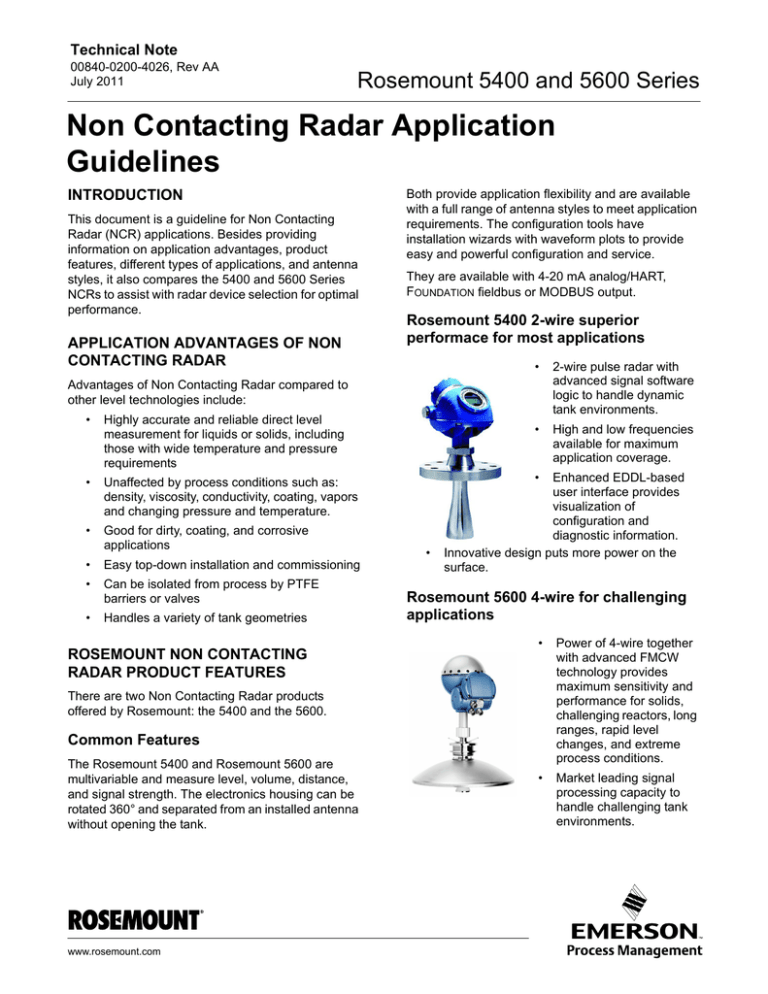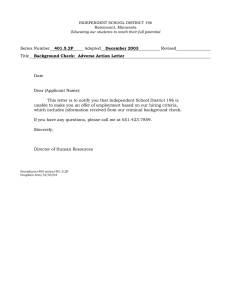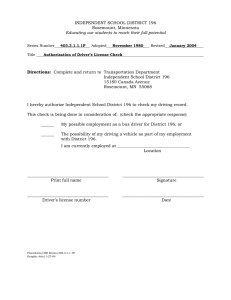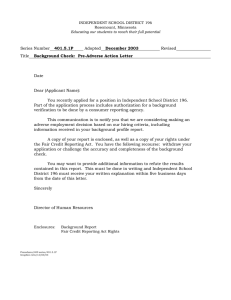
Technical Note
00840-0200-4026, Rev AA
July 2011
Rosemount 5400 and 5600 Series
Non Contacting Radar Application
Guidelines
INTRODUCTION
This document is a guideline for Non Contacting
Radar (NCR) applications. Besides providing
information on application advantages, product
features, different types of applications, and antenna
styles, it also compares the 5400 and 5600 Series
NCRs to assist with radar device selection for optimal
performance.
APPLICATION ADVANTAGES OF NON
CONTACTING RADAR
Both provide application flexibility and are available
with a full range of antenna styles to meet application
requirements. The configuration tools have
installation wizards with waveform plots to provide
easy and powerful configuration and service.
They are available with 4-20 mA analog/HART,
FOUNDATION fieldbus or MODBUS output.
Rosemount 5400 2-wire superior
performace for most applications
•
2-wire pulse radar with
advanced signal software
logic to handle dynamic
tank environments.
•
High and low frequencies
available for maximum
application coverage.
Advantages of Non Contacting Radar compared to
other level technologies include:
•
Highly accurate and reliable direct level
measurement for liquids or solids, including
those with wide temperature and pressure
requirements
•
Unaffected by process conditions such as:
density, viscosity, conductivity, coating, vapors
and changing pressure and temperature.
•
Good for dirty, coating, and corrosive
applications
•
Easy top-down installation and commissioning
•
Can be isolated from process by PTFE
barriers or valves
•
Handles a variety of tank geometries
ROSEMOUNT NON CONTACTING
RADAR PRODUCT FEATURES
•
•
Enhanced EDDL-based
user interface provides
visualization of
configuration and
diagnostic information.
Innovative design puts more power on the
surface.
Rosemount 5600 4-wire for challenging
applications
•
Power of 4-wire together
with advanced FMCW
technology provides
maximum sensitivity and
performance for solids,
challenging reactors, long
ranges, rapid level
changes, and extreme
process conditions.
•
Market leading signal
processing capacity to
handle challenging tank
environments.
There are two Non Contacting Radar products
offered by Rosemount: the 5400 and the 5600.
Common Features
The Rosemount 5400 and Rosemount 5600 are
multivariable and measure level, volume, distance,
and signal strength. The electronics housing can be
rotated 360° and separated from an installed antenna
without opening the tank.
www.rosemount.com
Technical Note
Rosemount 5400 and 5600 Series
00840-0200-4026, Rev AA
July 2011
APPLICATIONS
Pipes and Stilling Wells
Rosemount NCRs are suitable for a wide range of
applications. This section will give you an overview.
Rosemount non-contacting
radar is an excellent choice
for level measurement in
stilling wells. Stilling wells
minimize foam and
turbulence and the
tank-structure is invisible to
the radar because the
signal is confined within
the stilling well.
Demanding Enviromets
Unaffected by temperature, pressure, and vapor gas
mixtures, the enhanced radar capabilities provide
reliable measurements under challenging conditions.
Non-contacting is ideal for corrosive products such
as caustics, acids, and other chemicals.
Reactor and Mixing
Tanks
Rosemount non-contacting radar withstands the
challenge of reactor and mixing tanks. It is unaffected
by almost any fluid property change, including
density, pH, and viscosity.
Storage and Buffer Tanks
Rosemount non-contacting radar provides a very
reliable and accurate level reading with no moving
parts or contact with the process, thus eliminating
costly maintenance.
Solids Measurement
The Rosemount 5600
measures low dielectric
solids with a measuring
range capability to 160
ft. (50 m).
Applications include
powders and granules
such as lime, cement,
fly ash, corn, metals,
ore, and many more.
2
Technical Note
00840-0200-4026, Rev AA
July 2011
Rosemount 5400 and 5600 Series
TABLE 1. Sample of Non Contacting Radar Applications in Different Industries
Oil & Gas
Refining
Petrochemical
Chemical
Power (and plant Food & Beverage
Pulp & Paper
utilities)
(non-hygienic)
Water & Fuel
Storage
Mud and Cement
Mix Tanks
Flare Knock Out
Tanks
Fracturing
Blenders
Underground
Tanks
Slop Tanks
Sulphur Pits(1)
Blending Tanks
Sulphur
Coal Bunkers(1)(2)
Pet Food(1)(2)
Waste Water
Lube Oil Tanks
Lime(1)(2)
Pellets(1)(2)
Basins
Buffer Tanks
Acid Storage
Tanks
Caustic
Grain Silos(1)(2)
Buffer Tanks
Reactor Tanks
Solvents Tanks
Waste Water
Level
Fuel Storage
Wood Chip
Silos(1)(2)
Pulp Stock
Level(1)
Chemical Storage
Edible Oil Tanks
Fuel Storage
Blow-Down
Drums(1)
Bitumen Tanks
Finished Product
Storage
Fuel Storage
Solids Silos(1)(2)
Sugar
Waste Water
Flour
Caustic
Asphalt Tanks
Chemical
Storage
Blending Tanks
Waste Water
Starch Silos
Acid Storage
Tanks
Additive Tanks
Digesters(1)
Lime Silos(1)
Lube Oils
Blending Tanks
Reactor Tanks(3)
Alkylation Units
Liquid Propylene
Tanks
Lube Oil Tanks
End Product
Tanks
Glues
Resins
Antioxidants
Adhesives
Reactors(3)
Crystallizers(3)
Finished Product
Storage
Fuel Storage
Chemical Storage
Catalyst(1)(2) and
Spent Catalyst
Tanks
Coker Feed Tanks
Coke Silos(1)(2)
Flare Knock Out
Crude Storage
Fire Water
Storage
Safety Water
Storage
Chemical Storage
Acids Storage
Fly Ash(1)(2)
Cooling Tower
Basins
Water Intake
Screens
Rocksalt
Sawdust Silo(1)(2)
Black Liquor
Storage
Lake/Pond Level
Water Catchment
(1) 5600 first choice
(2) For shorter ranges and in cases when tensile load is not an issue; consider GWR
(3) 5600 if temperature exceeds limits of 5400
For further applications see the following link: http://emerson.d1asia.ph/MeasSolCat/index.aspx
3
Technical Note
00840-0200-4026, Rev AA
July 2011
Rosemount 5400 and 5600 Series
COMPARE AND SELECT ROSEMOUNT
NON CONTACTING RADARS
Basic Transmitter Selection
TABLE 2. Features of Interest(1)
Key Features
2-Wire, DC Power
4-Wire, DC or AC Pwr
2nd Analog Output
Configurable Display
Configurable Locally
Temperature Inputs
Relays
Primary Multivariable
Options
Volume Calc Available
Frequency
Accuracy -up to 33’
(10m)
5400
Yes
No
No
Yes
No
No
No
Level, Volume
5600
No
Yes, AC&DC
Yes
Yes
Yes
6
No
Level, Volume,
Temp
Yes
10 GHz
± 0.20 in
(5 mm)
Pressure Minimum and
Maximum Limits
Yes
6 or 26 GHz
± 0.12 in (3 mm)
5402
± 0.39 in (10 mm)
5401
RadarMaster /
EDDL, DTM
Compliant tools
Vacuum to:
232 psig (16 bar)
Temperature Minimum
and Maximum Limits
-40 °F (-40 °C) to
302 °F (150 °C)
Maximum Measuring
Range(2)
Minimum Practical
Range (URV-LRV)
Recmnd for small
vessels < 40”(1m)
115’ (35 m)
RadarMaster /
DD Compliant
tools
Vacuum to:
145 psi (10 bar)
Option: 798 psi
(55 bar)
-40 °F (-40 °C) to
392 °F (200 °C)
Option: 752 °F
(400 °C)
165’ (50 m)
4 in (0.1 m)
20 in (0.5 m)
Yes
Consult Factory
Configuration
5402: High Frequency Microwaves, 26GHz
•
Best fit for most applications
•
Less installation considerations
•
Narrow beam angle avoids disturbances more
easily
•
More focused energy provides longer
measuring range
5401/5600: Low Frequency Microwaves, 6/10GHz
•
Longer wave lengths penetrate foam and
heavy vapor and condensation more easily
•
Wide beam angle can in some cases pass
disturbances more easily (when the disturbing
echo is located directly under the radar)
BEAM ANGLES WITH 4” ANTENNAS
6 GHz
10 GHz
26 GHz
For a given size antenna, the beam width narrows as
frequency increases. (See Table 3 for details regarding
beam angle)
6 GHz/10 GHz
26 GHz
(1) For more information see Rosemount Level Instrumentation
brochure, 5400 and 5600 Product data Sheets.
(2) Varies greatly with dielectric constant of product and antenna
selection, see “Maximum recommended measuring range” on
page -7.
Frequency Selection
Low frequency is preferred when measuring in vapor
and foam. High frequency is preferred in most other
applications due to greater mounting flexibility.
4
Low frequency is preferred when measuring in vapor and
foam. High frequency is preferred in most other
applications due to greater mounting flexibility.
Technical Note
00840-0200-4026, Rev AA
July 2011
Rosemount 5400 and 5600 Series
Model and Antenna Selection Depending on Application
TABLE 3. Compare and Select Rosemount Non Contacting Radars
Model and Antenna Guide
This table gives guidelines on
which model and antenna to
select, depending on
application.
5402
Cone (preferred)
Process Seal
5601(1)
5401
Cone (preferred)
Rod
Cone
Parabolic
G=Good
AD=Application Dependent
(consult your local Emerson
representative)
NR=Not Recommended
Best choice for
a broad range
of applications,
free
propagation
and pipe
installations.
Ideal for small
tanks and
corrosive
applications.
Also good for
heavy antenna
condensation/
build-up.
Suitable for
some extreme
process
conditions.
Suitable for
small process
connections,
and corrosive
environment.
Suitable for
some extreme
process
conditions.
Higher temp
difficult
process
conditions.
Superior
microwave
management.
Require large
tank opening.
Best choice for
solids, long
range.(2)
G
G
G
G
G
NR
G
NR
G
AD
G
AD
AD
min 600 mm
G
AD
AD
min 600 mm
G
AD
G
G
NR
NR
AD
AD
2” 19°
3” 14°
4” 9°
2” 19°
3” 14°
4” 9°
4” 37°
6” 23°
8” 17°
37°
10°
G
G
G
G
G
AD(4)
G
NR(5)
3” 25°
4” 21°
6” 18°
8” 15°
G
AD(4)
G
AD(4)
AD(4)
AD
AD(4)
NR(5)
AD(4)
AD(4)
G 2”-4” pipe
G
NR
AD
G 2”-4” pipe
G
NR
G
G 3”-8” pipe
NR
NR
AD
NR
NR
NR
G
G 3”-6” pipe
AD
NR
AD
NR
NR
G
G
Tank Considerations
Installation close to smooth
tank wall
Multiple units on the same tank
Internal obstructions, directly in
path
Internal obstructions,
avoidance(3)
Beam angle
Antenna extends below nozzle
Antenna recessed in smooth
nozzle up to 6 ft (2 m)
Antenna recessed in nozzle
with irregularities, such as bad
welds
Stilling well mounting
Valves
Long ranges (>115´/ 35m)
Cleanability of antenna
(1) 5601 available with process seal and rod
(2) Dust cover
(3) The obstruction should not be within the radar beam. Preferred choices due to more narrow radar beam: Model 5402, and cone antenna.
(4) An extended cone antenna must be used.
(5) The active part must protrude beneath the nozzle.
5
Technical Note
00840-0200-4026, Rev AA
July 2011
Rosemount 5400 and 5600 Series
TABLE 4. Compare and Select Rosemount Non Contacting Radars
Model and Antenna Guide
This table gives guidelines on
which model and antenna to
select, depending on
application.
5402
Cone (preferred)
Process Seal
5601(1)
5401
Cone (preferred)
Rod
Cone
Parabolic
G=Good
AD=Application Dependent
(consult your local Emerson
representative)
NR=Not Recommended
Process Medium Characteristics
Vapor (light, medium)
Vapor (heavy)
Condensing vapor/product
build-up(2)
Boiling/Turbulent surface
(low/medium)
Boiling/Turbulent surface
(heavy)
Boiling/Turbulent surface
(still-pipe)
Foam(4)
Foam (still-pipe)(4)
Corrosive products (options
available)
Materials with very low
dielectric
Changing density/dielectric/
pH/ pressure/temperature
Coating/viscous/crystallizing
liquids
Solids, granules, powders
G
NR
AD
G
AD
G
G
G
G
G
G
AD
G
G
G
G
G
G
G
G
G
G
G
G
AD
AD
G(3)
NR
G
G
G
G
G
NR
G
G
NR
G
G(5)
NR
G
G(5)
AD
G
G(5)
AD
NR
G(5)
AD
G
G(5)
AD
G
G(5)
G
G
G
AD
G
G
G
G
G
G
G
G
G
G
G
G
G
G
NR
NR
NR
NR
AD(6)
G(6)
(1) 5601 available with process seal and rod
(2) Build-up can often be avoided or reduced by using heat-tracing or cleaning arrangements.
(3) Use a 6 or 8 in. cone antenna.
(4) Foam can either reflect, be invisible, or absorb the radar signal. Pipe mounting is advantageous since it reduces the foaming tendancy.
(5) See wetted material in PDS.
(6) See Technical Note “Measuring Solids With a Rosemount 5600 Non-Contacting Radar” (00840-0100-4024).
6
Technical Note
00840-0200-4026, Rev AA
July 2011
Rosemount 5400 and 5600 Series
Maximum recommended measuring range
TABLE 5. Rosemount 5402, Maximum Recommended Measuring Range, ft (m)
High Frequency
Antennas
Dielectric Constant(1)
A
B
C
A
B
C
A
B
C
2-in. Cone / Process Seal
33 (10)
49 (15)
66 (20)
82 (25)
115 (35)
115 (35)
9.8 (3)
20 (6)
33 (10)
3-in. Cone / Process Seal
49 (15)
66 (20)
98 (30)
82 (25)
115 (35)
115 (35)
13 (4)
30 (9)
39 (12)
4-in. Cone / Process Seal
66 (20)
82 (25)
115 (35)
82 (25)
115 (35)
115 (35)
23 (7)
39 (12)
49 (15)
(1) A. Oil, gasoline or other hydrocarbons, and petrochemicals (r=1.9-4.0)
In pipes or with ideal surface conditions, for some liquefied gases (r=1.4-4.0)
B. Alcohols, concentrated acids, organic solvents, oil/water mixtures, and acetone (r=4.0-10.0)
C. Conductive liquids, e.g. water based solutions, dilute acids, and alkalis (r>10.0)
TABLE 6. Rosemount 5401, Maximum Recommended Measuring Range, ft (m)
Low Frequency
Antennas
Dielectric Constant(1)
A
B
C
A
B
C
A
B
C
NA
NA
NA
82 (25)
115 (35)
115 (35)
NA
NA
NA
4-in. Cone / Rod(3)
23 (7)
39 (12)
49 (15)
82 (25)
115 (35)
115 (35)
13 (4)
26 (8)
39 (12)
6-in. Cone
43 (13)
66 (20)
82 (25)
82 (25)
115 (35)
115 (35)
20 (6)
33 (10)
46 (14)
8-in. Cone
66 (20)
82 (25)
115 (35)
82 (25)
115 (35)
115 (35)
26 (8)
39 (12)
52 (16)
3-in. Cone
(2)
(1) A. Oil, gasoline or other hydrocarbons, and petrochemicals (r=1.9-4.0)
In pipes or with ideal surface conditions, for some liquefied gases (r=1.4-4.0)
B. Alcohols, concentrated acids, organic solvents, oil/water mixtures, and acetone (r=4.0-10.0)
C. Conductive liquids, e.g. water based solutions, dilute acids, and alkalis (r>10.0)
(2) Pipe installations only. NA=not applicable.
(3) Pipe installations are not allowed with rod antennas.
7
Technical Note
00840-0200-4026, Rev AA
July 2011
Rosemount 5400 and 5600 Series
TABLE 7. Rosemount 5601, Maximum Recommended Measuring Range, ft (m)
Rosemount 5600 Series
3-in. Cone
4-in. Process Seal
6-in. Process Seal
Rod/4-in. Cone
6-in. Cone
8-in. Cone
Parabolic
3-6-in. Cone in Still-Pipe
A
52 (16)
49 (15)
59 (18)
82 (25)
98 (30)
115 (35)
131 (40)
-
B
72 (22)
51 (15.5)
67 (20.5)
89 (27)
112 (34)
148 (45)
164 (50)
-
C
92 (28)
59 (18)
80 (24.5)
98 (30)
131 (40)
164 (50)
164 (50)
-
Dielectric Constant(1)
A
B
C
30 (9)
39 (12)
52 (16)
31 (9.5)
34 (10.5) 41 (12.5)
36 (11)
41 (12.5) 54 (16.5)
52 (16)
59 (18)
71 (21.5)
66 (20)
80 (24.5) 92 (28)
85 (26)
95 (29)
107 (32.5)
98 (30)
115 (35)
131 (40)
-
A
16 (5)
8 (2.5)(2)
10 (3)(2)
10 (3)
21 (6.5)
26 (8)
46 (14)
164 (50)
B
20 (6)
11 (3.5)(2)
20 (6)(2)
21 (6.5)
33 (10)
46 (14)
82 (25)
164 (50)
C
21 (6.5)
20 (6)(2)
23 (7)(2)
33 (10)
43 (13)
52 (16)
98 (30)
164 (50)
(1) A. Oil, gasoline and other hydrocarbons, petrochemicals (dielectric constant, r=1.9-4.0), in pipes (r>1.4)
B. Alcohols, concentrated acids, organic solvents, oil/water mixtures, and acetone (r=4.0-10)
C. Conductive liquids, e.g. water based solutions, dilute acids, and alkalis (r > 10)
(2) Not recommended.
Standard Terms and Conditions of Sale can be found at www.rosemount.com/terms_of_sale
The Emerson logo is a trade mark and service mark of Emerson Electric Co.
Rosemount and the Rosemount logotype are registered trademarks of Rosemount Inc.
PlantWeb is a registered trademark of one of the Emerson Process Management group of companies.
All other marks are the property of their respective owners.
© 2011 Rosemount Inc. All rights reserved.
Emerson Process Management
Rosemount Measurement
8200 Market Boulevard
Chanhassen MN 55317 USA
Tel (USA) 1 800 999 9307
Tel (International) +1 952 906 8888
Fax +1 952 949 7001
00840-0200-4026 Rev AA, 07/11
Emerson Process Management
Blegistrasse 23
P.O. Box 1046
CH 6341 Baar
Switzerland
Tel +41 (0) 41 768 6111
Fax +41 (0) 41 768 6300
Emerson FZE
P.O. Box 17033
Jebel Ali Free Zone
Dubai UAE
Tel +971 4 811 8100
Fax +971 4 886 5465
Emerson Process Management Asia Pacific
Pte Ltd
1 Pandan Crescent
Singapore 128461
Tel +65 6777 8211
Fax +65 6777 0947
Service Support Hotline : +65 6770 8711
Email : Enquiries@AP.EmersonProcess.com



